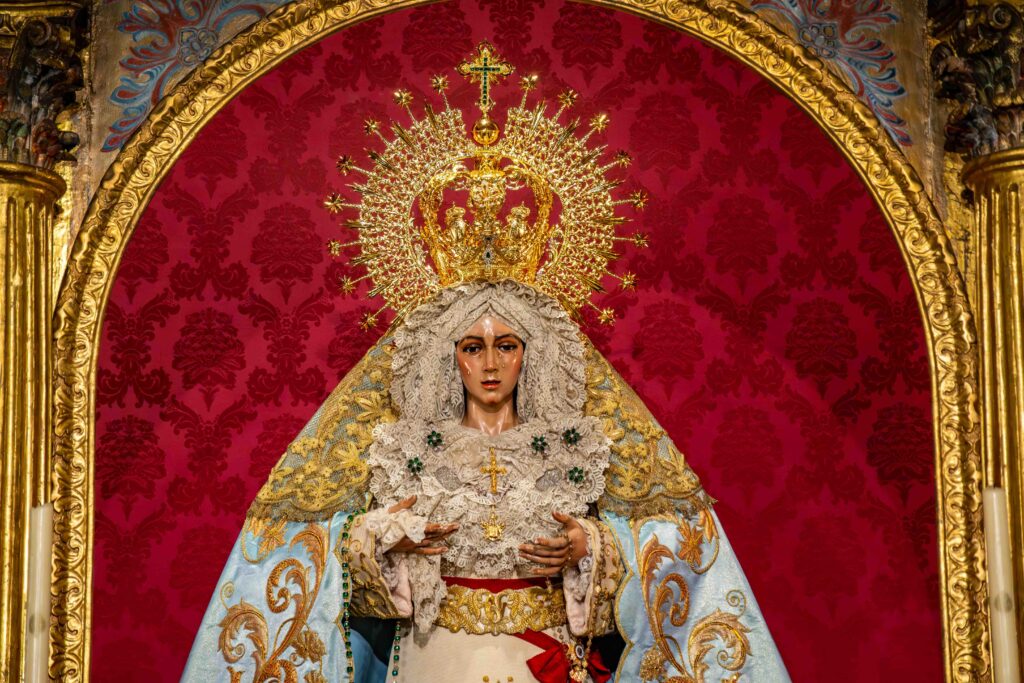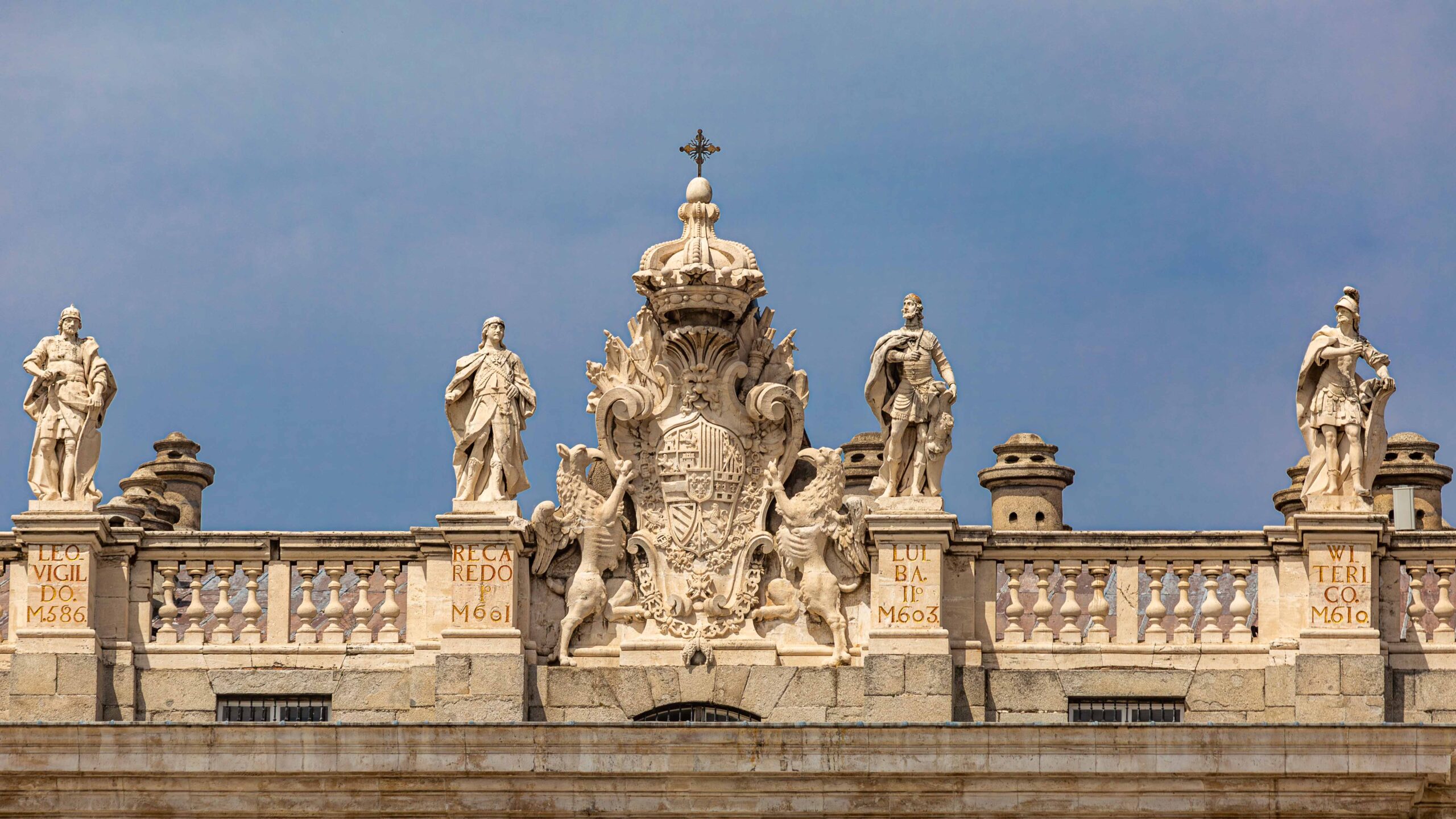
Seville Cathedral
In Seville we had tickets to guess where? Yep, the Seville Cathedral and the Royal Alcazar. The Cathedral of Saint Mary of the See, was completed in the early 16th century and became the largest church in the world. Depending on how you measure it now only holds 1st place for exterior and 4th place for interior. In typical Gothic fashion, it is cavernous and dark and full of extreme ornamentation. Bill is always offended by the riches contained in these churches, and the work that must have gone into creating them, while so many people at the time lived in poverty. I thought the Alcazar rivaled the Alhambra. There were many styles of decoration, combining the Moorish plasterwork on the ceilings, arches and walls, with painted Spanish tiles. Overall, there was more color and variety to the décor and it appeared to be in better condition than the Alhambra. The gardens were lovely, and there was a Grotto Gallery, a raised walkway, from which you could admire the view.

Seville Royal Alcazar
When we got to Cordoba, they were having a Courtyards Festival. We only had one day in town, so we passed on the typical sightseeing (we were a little burnt out on the cathedral, palace tours) in favor of the festival. There were probably at least 50-60 homes in five zones that opened their courtyards to the public, although we only saw about a dozen (we could only go in the evening as by the time we arrived the courtyards were closed for ‘siesta’). At some we had to wait in line to enter because they controlled the number of people that were inside. That was actually nice because it allowed us to get better photos. Some of them were pretty large, and they were all packed with flowers in pots. It would take lots of work to create such gardens every year, not to mention watering every day. That evening we went to “Naturaleza Encendida”, a light show in the gardens of the Alcazar. It was billed as a “magical immersive experience”, and Bill enjoyed it (it was a change over our ‘normal’ sightseeing. I had hoped it would be more like what we stumbled across in Rome where the light show was timed to music. Here they simply lit up the gardens and fountains in different colors. Although they did project a changing pattern on the wall of the Alcazar), but I thought it was kind of lame.

Cordoba Courtyard
On the way to Madrid, we made a quick detour to Toledo, an ancient walled city that sits on hill. Bill had a route planned that would take us to the best viewpoints, but we were soon blocked by a road closure due to a rock slide. Eventually we managed to go around the long way to get to the old gates and a good view from across the Tagus River that wraps around the city.

Walled City of Toledo
By the time we got to Madrid we were very tired of sightseeing. Fortunately, we had a week in one place, so for two days we only left our Airbnb to eat or buy groceries (we spent the time working on the blog and pictures and I even played a little golf on a swing simulator I brought with us). The break really helped, and we were much revived by the time we went to check out the last day of the San Isidro Festival. We found a Spanish folk dancing performance and followed it by a visit to a famous churro café where they gave us a cup full of hot chocolate sauce to dip them in (I think the Spanish consider it a drink but as Dessa pointed it out it had the consistency of a dark chocolate syrup – it was good though). As we continued our walk, some church bells started to ring. We checked our watches when they kept ringing beyond the normal telling of time, trying to figure out what was going on. They rang for several minutes. Turns out we were at the Church of San Isidro and the bells were calling the faithful to visit the remains of the patron saint of the city of Madrid, Isidore the Laborer, and his wife, Saint Mary of the Head. The bells worked because there was a long (and growing) line of people waiting to go inside their chapel in the back of the church.

Church of San Isidro
Again, I had waited too long to get tickets to The Royal Palace of Madrid, but that was ok since we have lots of palaces coming up in Germany (they do sell tickets at the door but there was another large line and it looked like they were only allowing these people in when someone left so the line was moving sloooowly).
The Almudena Cathedral right next door was a surprise. It was completed and consecrated in 1993, so in relative terms it is very brand new. The ceiling is banded in geometric stripes that look like a mosaic of stained glass, and the seven frescoes above the altar appear to be art deco in style. They caused a big controversy in Spain, because the painter was a friend of the Pope’s. The work was considered by some as infantile and amateurish, when there are so many other great artists that could have been chosen. I thought it was refreshing after the heavily decorated excess in the previous cathedrals we had visited. We spent some more time just wandering the streets of Madrid. There were lots of lovely old buildings, wonderful huge parks, and tons of people everywhere.

Almudena Cathedral
Our last day in Madrid was spent taking a drive to Segovia, an hour from Madrid, that had an amazing aqueduct. It was built in the first century AD, and was still in use until 1973, bringing water from the mountains 11 miles away. It is 93 feet tall at the highest point, and really impressive. Hard to believe that it is 1800 years old, and we had to marvel at what a feat it was to engineer and construct (and that it was still standing – anyone want to take bets on whether anything our generation has built will survive 1800 years). The Segovia Cathedral had some very nice fully restored paintings in some of the naves, but the real treasure was under the attached cloister, where they had a small museum of truly beautiful art, mostly the 1500’s, in a museum setting. In many of the churches we have visited the paintings have not been cleaned and are poorly lighted, but these were fantastic.

Aqueduct in Segovia
Like most Europeans, we walked everywhere, rarely using public transit, and adopted the custom of shopping for food every day, and having dinner at 9pm. It was easy to understand why they take a siesta, since they seem to drink all day (we often saw people in the cafes drinking beer before 11am) but I didn’t. Communicating was a challenge at times, since a lot of natives spoke about as much English as we spoke Spanish. Dining out and shopping required translating all the menus and labels (Google Translate was usually our friend). Most stores, including the grocery stores, were closed on Sundays and on holidays, but eating out was pretty inexpensive, and food at the grocery stores and bakeries was definitely cheap. We have really enjoyed our time in Spain, especially the nice warm, sunny weather.
Now on to Germany.
…Bill & Dessa
